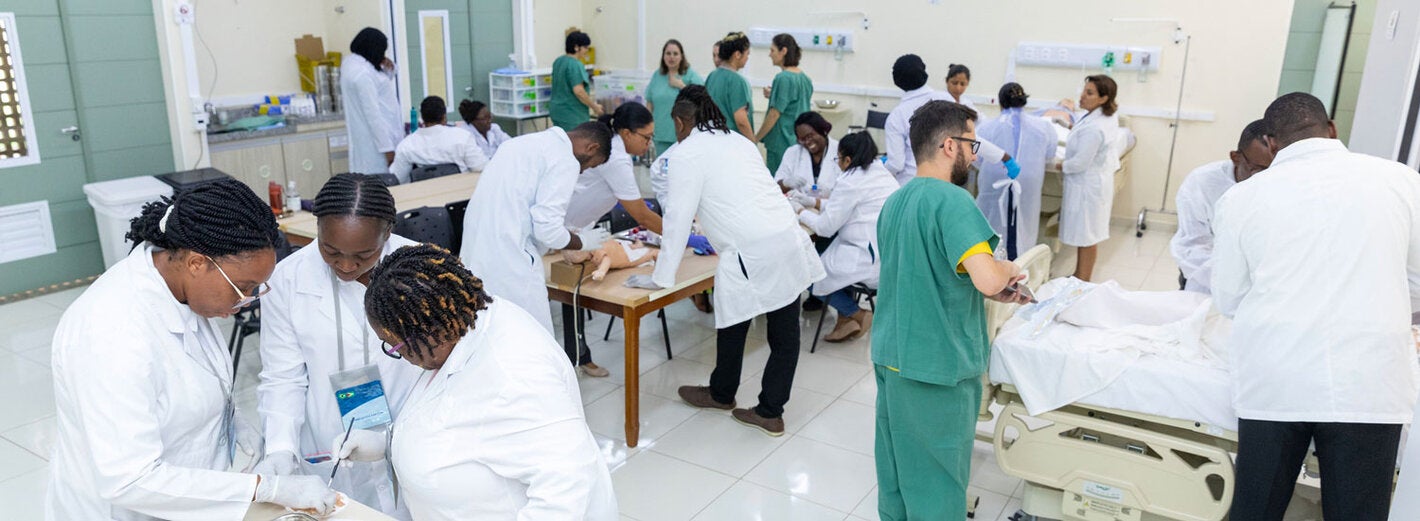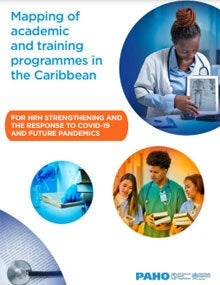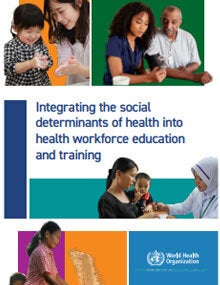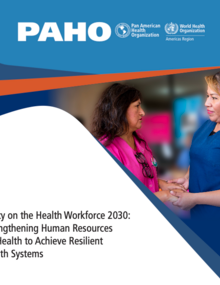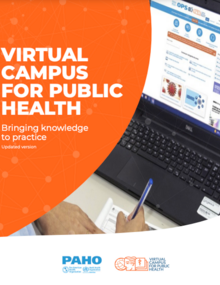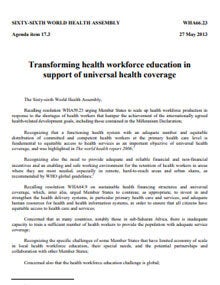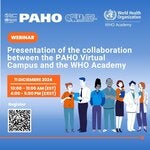It is essential to improve the education of human resources for health (HRH) to achieve sufficient availability, accessibility, acceptability, and quality in the HRH workforce.
It is necessary to transform HRH education to achieve universal health for everyone everywhere, and to build resilient health systems with integrated health service networks and a strong, responsive first level of health care.
The fourth strategic line of the Policy on the Health Workforce 2030—"Strengthening human resources for health for resilient health systems"—refers to enhancing the development of the health workforce and strengthening its capacity to address public health priorities, while improving preparedness and response to public health emergencies, with a focus on:
- Collaboration between the education and health sectors through competency-based education, particularly for interprofessional teams at the first level of care.
- Continuing education strategies: based on flexible training itineraries; incorporating micro-credentials; linked to processes for the regulation, accreditation, and relicensing of health workers; and encouraging the participation of professional associations and public-private educational alliances in strategy development.
- Expanded access to PAHO's Virtual Campus for Public Health, and its use as a space for the convergence of high-quality learning tools.
PAHO seeks to help Member States to:
- Ensure adequate availability of health workers (44.5 health workers per 10 000 population) who are qualified, culturally and linguistically suitable, and well distributed.
- Strengthen the quality of training for health professionals, in collaboration with the education sector, through the development of evaluation and accreditation systems for training institutions and degree programs.
- There is a shortfall of more than 18 million professionals in the world—and more than two million in the Americas—, primarily affecting the first level of care, vulnerable groups, and rural areas.1,2
- Current disease-centered education plans, with deficiencies in the quality of higher education, inadequate selection mechanisms, and high attrition, make it difficult to train more and better professionals to work in the health sector.3,4
- There are chronic and persistent gaps in HRH capacity, availability, and quantity. These were exacerbated during the COVID-19 pandemic, with lessons learned regarding the education of active workers and trainees.5
:: Sources
- Frenk J, Chen LC, Chandran L, Groff EOH, King R, Meleis A, et al. Challenges and opportunities for educating health professionals after the COVID-19 pandemic. The Lancet [Internet]. octubre de 2022;400(10362):1539–56. Disponible en: https://www.thelancet.com/journals/lancet/article/PIIS0140-6736(22)0209…
- Frenk J, Chen L, Bhutta ZA, Cohen J, Crisp N, Evans T, et al. Health professionals for a new century: Transforming education to strengthen health systems in an interdependent world [Internet]. Vol. 376, The Lancet. 2010. Disponible en: https://www.thelancet.com/journals/lancet/article/PIIS0140-6736(10)61854-5/fulltext
- Vieira do Nascimento D, Roser-Chinchilla Jaime, Mutize T akudzwa. Hacia el acceso universal a la educación superior: tendencias internacionales [Internet]. UNESCO, editor. Disponible en: https://unesdoc.unesco.org/ark:/48223/pf0000375683?posInSet=1&queryId=a22c64ea-fdb2-4f4d-80d3-67068d4ca618
- Organización Mundial de la Salud. Estrategia mundial de recursos humanos para la salud: personal sanitario 2030. Vol. 132, 69a Asamblea Mundial de la Salud. 2016
- Organización Panamericana de la Salud. Política sobre el personal de salud 2030: fortalecimiento de los recursos humanos para la salud a fin de lograr sistemas de salud resilientes. [Documento CD60/6]. 60.o Consejo Directivo, 75.a Sesión del Comité Regional de la OMS para las Américas; del 25 al 29 de septiembre del 2023. [Internet]. Washington; 2023. Disponible en: https://www.paho.org/es/documentos/cd606-politica-sobre-personal-salud-…
- Difficulties persist in achieving adequate and sustainable access to education for all health workers. This prevents the development and maintenance of a sufficient, qualified, well-distributed workforce at all levels of health care.
- Educational models that are predominantly clinical—tending toward hyper-specialization and a focus on the health needs of populations with high income levels and in urban settings—have an adverse effect on the goal of achieving universal health for everyone, everywhere. These models also generate limited access to education for workers in rural and underserved areas. 1
- Changes in the global context—characterized by greater social-cultural diversity and interconnectedness, innovations in technology and neuroscience, unequal economic growth, intolerance and violence, ecological stress, climate change, and unsustainable development models—require a more sustainable and universal education. 2,3
- It is necessary to transform education to achieve universal access and greater quality in higher education and health. Challenges include inequalities between territories, poverty, crisis and emergency situations, geographic mobility, and discrimination, all of which impact health workers. 4,5
:: Sources
- Evans T, Araujo E, Herbst C, Pannenborg O. Transforming Health Workers’ Education for Universal Health Coverage: Global Challenges and Recommendations. World Health Popul [Internet]. el 30 de septiembre de 2017;17(3):70–80. Disponible en: https://doi.org/10.12927/whp.2017.25304.
- Organización Panamericana de la Salud. Cómo atraer, captar y retener al personal de salud en zonas rurales, remotas y desatendidas. Una revisión rápida [Internet]. OPS; 2022. Disponible en: https://iris.paho.org/handle/10665.2/55873.
- UNESCO. Replantear la educación: ¿Hacia un bien común mundial? Organización de las Naciones Unidas para la Educación, la Ciencia y la Cultura [Internet]. 2015;43. Disponible en: https://www.unesdoc.unesco.org/ark:/48223/pf0000232697).
- Vieira do Nascimento D, Roser-Chinchilla Jaime, Mutize T akudzwa. Hacia el acceso universal a la educación superior: tendencias internacionales [Internet]. UNESCO, editor. Disponible en: https://unesdoc.unesco.org/ark:/48223/pf0000375683?posInSet=1&queryId=a22c64ea-fdb2-4f4d-80d3-67068d4ca618
- Organización Mundial de la Salud. Estrategia mundial de recursos humanos para la salud: personal sanitario 2030. Vol. 132, 69a Asamblea Mundial de la Salud. 2016)
In this context, PAHO is promoting the Policy on the Health Workforce 2030: Strengthening Human Resources for Health to Achieve Resilient Health Systems. This policy has a strategic line of action that emphasizes the importance of addressing HRH education, including competency-based continuing education strategies and plans; education of interprofessional teams (IPTs) in integrated Primary Health Care-based health service networks; development of flexible training itineraries; and integration of technologies in the education of health personnel.





